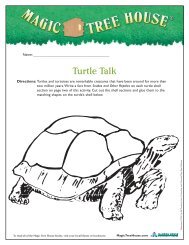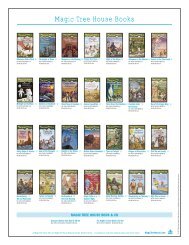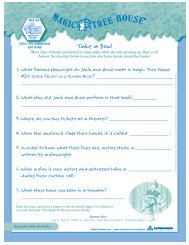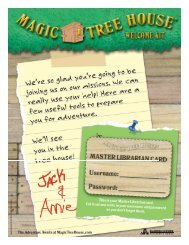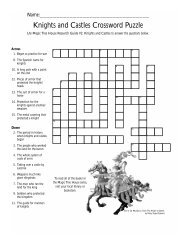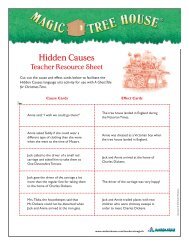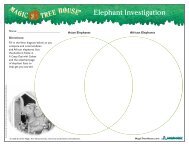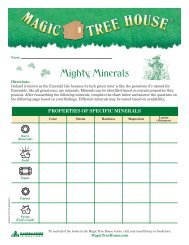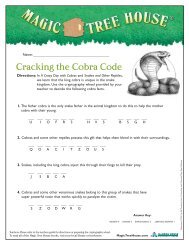Pandas - Magic Tree House
Pandas - Magic Tree House
Pandas - Magic Tree House
You also want an ePaper? Increase the reach of your titles
YUMPU automatically turns print PDFs into web optimized ePapers that Google loves.
R<br />
FACT TRACKER<br />
<strong>Pandas</strong><br />
and Other<br />
Endangered Species<br />
FACT TRACKER<br />
MTH48<br />
A NONFICTION<br />
COMPANION TO<br />
MAGIC TREE HOUSE #48:<br />
A Perfect Time<br />
for <strong>Pandas</strong><br />
Mary Pope Osborne and Natalie Pope Boyce<br />
Chapter Sample
Climb the ladder to adventure by<br />
reading<br />
books!<br />
Turn the page for a sneak peek . . .
1<br />
<strong>Pandas</strong> and Other<br />
Endangered Species<br />
April 16, 1972, was a crazy day in Washington,<br />
D.C.<br />
Outside the National Zoo, cars were<br />
lined up bumper to bumper. Twenty thousand<br />
people waited in long lines at the<br />
gates. All of this fuss was about two chubby<br />
little panda cubs named Hsing Hsing and<br />
Ling Ling. They had just arrived as gifts<br />
from the Chinese government.<br />
1
At this time, there were no other pandas<br />
in the United States. Ling Ling and Hsing<br />
Hsing were so special, they came with their<br />
own bodyguards! The pandas became the<br />
most popular animals at the zoo. Over the<br />
years, millions of people visited them.<br />
Ling Ling was a female, and Hsing Hsing<br />
was a male.<br />
2
Endangered Species<br />
Ling Ling and Hsing Hsing came from<br />
the high mountain forests of China. These<br />
mountains are home to all giant pandas<br />
living in the wild. <strong>Pandas</strong> are a badly<br />
endangered species.<br />
A species is endangered when its<br />
numbers have become so small that the<br />
species is at risk of becoming extinct (ex-<br />
STINKT), or dying out. Today only about<br />
1,600 pandas remain in the wild.<br />
It’s not only pandas that are in trouble.<br />
All over the world, thousands of living<br />
things are in danger of disappearing<br />
forever.<br />
A species<br />
is a group<br />
of plants or<br />
animals that<br />
are alike in<br />
certain ways.<br />
Extinction<br />
Animals and plants have been on earth<br />
for hundreds of millions of years. At<br />
3
Over 800<br />
animal and<br />
plant species<br />
have become<br />
extinct in<br />
the past<br />
500 years.<br />
first, extinction happened in natural<br />
ways. Volcanic eruptions, for example,<br />
sometimes lasted thousands or even<br />
millions of years. Over time, events like<br />
this caused the extinction of millions of<br />
species. The one most people know about<br />
is when dinosaurs disappeared about 65<br />
million years ago.<br />
Extinction is a natural process—<br />
it makes way for lots of new species.<br />
But humans are causing animals and<br />
plants to become extinct too quickly,<br />
and fewer new species are taking their<br />
place. Species are being lost so fast that<br />
many are gone before they’ve even been<br />
discovered!<br />
Habitat Destruction<br />
Habitats are the places where certain<br />
plants and animals live. There are more<br />
4
people on earth now than ever before.<br />
Because the human population keeps<br />
growing, people are changing the land.<br />
They are destroying the habitats of many<br />
species.<br />
Human development of wetlands,<br />
grasslands, and tropical forests causes<br />
habitat loss. The land is used for things<br />
like farming, logging, mining, factories,<br />
and housing.<br />
Giant pandas once lived in forests<br />
throughout southern and eastern China.<br />
Now they live only in the mountains of<br />
central China. China has over a billion<br />
people—more than any other country in<br />
the world.<br />
When people think of forests, they<br />
think of trees. <strong>Pandas</strong> live in bamboo<br />
forests, but bamboo is a type of grass.<br />
There are almost 1,500 species of bamboo<br />
When their<br />
habitats are<br />
destroyed,<br />
animals can’t<br />
find enough<br />
food or shelter.<br />
There are<br />
more than<br />
7 billion<br />
people on<br />
the planet.<br />
5
in forests around the world. Because<br />
people cut down many of the bamboo<br />
forests, pandas lost much of their habitat.<br />
The bamboo cleared from this forest was<br />
mostly used for flooring.<br />
6
Pollution and Climate Change<br />
Pollution is harmful for all living things.<br />
Chemicals and waste such as oil, pesticides,<br />
or sewage pollute the soil, air, and water<br />
and put many species at risk.<br />
Climate change is another problem.<br />
When gases given off by factories and<br />
cars stay in the air above the earth, heat<br />
7
Even a oneor<br />
two-degree<br />
difference<br />
in the<br />
temperature<br />
of the earth<br />
can cause<br />
changes in<br />
the climate.<br />
cannot escape. Most scientists say that<br />
this is warming the earth and causing<br />
rapid climate change. Some animals will<br />
have to move to cooler places if they can.<br />
Other species will simply die out. Ice in<br />
the Arctic is melting so quickly that polar<br />
bears have to swim farther to catch seals.<br />
Polar bears don’t have any other place to<br />
live—they can’t move somewhere cooler.<br />
Illegal hunting<br />
for sport is<br />
also reducing<br />
the numbers of<br />
many animals.<br />
Hunting and Poaching<br />
Many countries have laws to protect<br />
certain animals and plants. Poachers<br />
break these laws and make money by<br />
killing and capturing certain animals or<br />
digging up plants.<br />
In Africa, poachers kill elephants for<br />
the ivory from their tusks. The black<br />
rhinoceros is also at great risk because<br />
of a false belief that its horn cures cancer.<br />
8
People are even stealing black rhinoceros<br />
horns from museums! An organization has<br />
been airlifting black rhinos to secret areas<br />
that are safer from poachers.<br />
New Species<br />
People often spoil habitats by bringing<br />
new species to places where they don’t<br />
9
Eco comes<br />
from a Greek<br />
word meaning<br />
home.<br />
normally live. This upsets the balance<br />
of an ecosystem. An ecosystem is all the<br />
living things and the place where they<br />
live together. Many rivers, lakes, and<br />
ponds are having problems because new<br />
species of fish or plants have taken over<br />
and are endangering the species already<br />
living there.<br />
Threats for All Species<br />
Habitat destruction<br />
Pollution and climate change<br />
Hunting and poaching<br />
New species in an ecosystem<br />
To conserve<br />
means to<br />
protect and<br />
save. People<br />
who protect<br />
the environment<br />
are called<br />
conservationists.<br />
Help for Endangered Species<br />
Many people are working to help endangered<br />
species and to conserve their<br />
habitats. Most of them do this by finding<br />
10
ways to save the habitats where animals<br />
and plants live. Some do this by learning<br />
more about living things and what kind of<br />
habitats they need. Others help by setting<br />
up parks and nature reserves that protect<br />
the plants and animals living there.<br />
<strong>Pandas</strong> and other endangered species<br />
cannot survive without human help. We all<br />
need to be conservationists!<br />
Volunteers clean seabirds after the oil spill<br />
off the coast of New Orleans in 2010.<br />
11
Whooping It Up<br />
Scientists at the Patuxent Wildlife Research<br />
Center in Maryland are working to save<br />
whooping cranes. These big white birds are<br />
one of the most endangered kinds of crane<br />
in the world.<br />
The scientists don’t want the chicks they<br />
raise to get too used to people. To prepare<br />
the birds for life in the wild, workers wear<br />
long white robes and hoods. Whenever the<br />
workers feed the chicks or take them for a<br />
swim, they lead them around with a puppet<br />
on a stick that looks like a crane’s head.<br />
When the chicks are ready to fly,<br />
ultralight aircraft with pilots also dressed<br />
in robes guide the young cranes on their<br />
12
first trip to their winter feeding grounds in<br />
Florida. The trip is over 1,200 miles and can<br />
take two months!<br />
13
2<br />
China’s National<br />
Treasures<br />
For at least 3,000 years, the Chinese<br />
have written stories and poems about<br />
giant pandas. Ancient writings say that<br />
emperors kept these bears as a sign of<br />
wealth. A giant panda’s skull was found<br />
in the tomb of an empress who lived<br />
over 2,000 years ago. Skins and bones<br />
of pandas have been discovered in older<br />
tombs as well. Today pandas are China’s<br />
national symbol of peace and friendship.<br />
<strong>Pandas</strong> have<br />
been around<br />
for over<br />
3 million<br />
years!<br />
15
World of the Giant Panda<br />
All the forests of southern and eastern<br />
China were once the home of pandas. Now<br />
they live in the south-central mountains of<br />
the Sichuan, Shaanxi, and Gansu provinces.<br />
The Chinese government has set up nature<br />
All wild pandas live<br />
in these provinces<br />
in China.<br />
16
eserves in these mountains to protect<br />
pandas and other species of plants and<br />
animals.<br />
Mist and clouds drift over the mountains<br />
there. Heavy rains fall on the trees and the<br />
thick groves of bamboo covering the slopes.<br />
China<br />
17
A number of<br />
plants and<br />
animals that<br />
live here<br />
are also<br />
endangered.<br />
These ancient, lonely mountains are the<br />
home of all the wild giant pandas, as well<br />
as rare and interesting animals such as<br />
blood pheasants, bamboo rats, and even<br />
another bear—the Asiatic black bear.<br />
Clouded leopards with spots shaped<br />
like clouds, golden snub-nosed monkeys<br />
with pale blue faces, and red pandas, which<br />
look like raccoons, hide in the tall trees.<br />
Red pandas are also a threatened<br />
species. They are not related to giant<br />
pandas.<br />
18
Giant Bear Cats<br />
One of the Chinese names for panda is giant<br />
bear cat. At one time, people thought that<br />
pandas were in the raccoon family. Recently<br />
scientists discovered that pandas are a<br />
unique species of bear. Even though pandas<br />
are in the bear family, they’re different in<br />
many ways from other bears.<br />
<strong>Pandas</strong> don’t have round eyes. Their<br />
pupils are vertical (straight up and down)<br />
like a cat’s eye. That’s one reason for that<br />
Chinese name.<br />
vertical pupils<br />
19<br />
round pupils
Most bears are omnivores, eating both<br />
plants and meat. But pandas are a grasseating<br />
bear. Almost all of their diet comes<br />
from bamboo.<br />
Most bears hibernate in the winter,<br />
when food is hard to find. Bamboo grows all<br />
winter long. <strong>Pandas</strong> don’t store fat in their<br />
<strong>Pandas</strong> usually sleep twelve to fourteen<br />
hours a day.<br />
20
odies like many other bears. They must<br />
have food all the time.<br />
During the winter, pandas move lower<br />
down the mountains, where it’s warmer.<br />
Their thick woolly coats have two layers<br />
of fur. They stay warm even in the snow.<br />
Giant pandas have five toes with claws,<br />
plus a long wrist bone that acts like an<br />
opposable thumb. An opposable thumb<br />
can move in different directions and pick<br />
up things. Apes, humans, and a few other<br />
animals have opposable thumbs.<br />
Possums have<br />
opposable<br />
thumbs on<br />
their back<br />
feet.<br />
Panda Ways<br />
Like most bears, giant pandas don’t live<br />
in groups. Giant pandas might share the<br />
same groves of bamboo, but they usually<br />
only get together to mate.<br />
When pandas feel threatened, they<br />
21
ob their heads, stare, and growl. They<br />
also might hit with their front paws, lunge<br />
forward, or bite.<br />
To show they don’t want to fight, pandas<br />
cover their eyes and muzzles with their<br />
paws and turn their heads.<br />
22
Wild pandas don’t travel far. Their<br />
bodies are thick and heavy. Because bamboo<br />
forests are so dense, the bears are not built<br />
to run in short bursts of speed like many<br />
other bears.<br />
Although pandas live on the ground,<br />
they’re also comfortable in trees. They<br />
climb up to sun themselves, take naps, and<br />
escape predators.<br />
<strong>Pandas</strong> use their sharp claws to climb trees.<br />
23
Panda Noises<br />
<strong>Pandas</strong> communicate with a variety of<br />
bleats, barks, and honks. Adult pandas<br />
woo their mates with special noises<br />
during mating season. Sometimes they<br />
sound like a bleating goat, or they make<br />
a sort of huffing noise.<br />
That’s about<br />
ten times<br />
as much as<br />
an average<br />
person eats<br />
each day!<br />
A Special Diet<br />
In the wild, the giant pandas’ diet is 99<br />
percent bamboo. When they eat, they sit<br />
on the ground with their feet stretched<br />
out in front, much like a human sits.<br />
Giant pandas have been known to<br />
spend up to sixteen hours a day eating.<br />
They eat thirty to forty pounds of food in<br />
one day!<br />
The reason that pandas eat so much is<br />
that bamboo doesn’t have many nutrients<br />
24
<strong>Pandas</strong> in the wild eat forty-two<br />
different species of bamboo.<br />
(NOO-tree-intz). They need to consume<br />
a lot. Bamboo is also hard to digest and<br />
passes through their bodies very quickly.<br />
25<br />
Nutrients are<br />
the vitamins,<br />
minerals, and<br />
proteins needed<br />
to be healthy.
Bamboo is about 90 percent water, but<br />
pandas still drink from streams. They also<br />
sit in them to cool off.<br />
<strong>Pandas</strong> love to feast on the first sweet<br />
sprouts of bamboo, but they eat all of the<br />
plant—the leaves, shoot, and roots.<br />
26
Bamboo is hard to chew. <strong>Pandas</strong> have<br />
strong jaws, and their back teeth are flat<br />
like those of cattle or goats. These teeth<br />
crush and grind the bamboo. Their front,<br />
sharper teeth bite through the tough stalks.<br />
<strong>Pandas</strong> have a strong bite, stronger than a<br />
lion or tiger!<br />
Annie, if you tried to<br />
eat bamboo, I bet it<br />
would really scratch<br />
your throat.<br />
I know! But pandas<br />
have very tough<br />
throats so the bamboo<br />
doesn’t hurt them.<br />
27
The San Diego Zoo treated two-yearold<br />
Yun Zi to a birthday cake made of<br />
bamboo leaves and colored pieces of ice.<br />
28
<strong>Pandas</strong> in zoos also eat bamboo, but<br />
they eat other things as well. Their<br />
keepers feed them carrots, apples, sweet<br />
potatoes, and biscuits with lots of fiber.<br />
<strong>Pandas</strong> like to eat different kinds of<br />
bamboo, and they like certain parts of<br />
the bamboo at different times.<br />
Today forest experts are planting<br />
different kinds of bamboo next to each<br />
other in panda reserves. They hope that<br />
when one species of bamboo dies, others<br />
will be there for the pandas to eat.<br />
Wild pandas<br />
will sometimes<br />
eat other<br />
grasses and<br />
roots or small<br />
rodents.<br />
Life Span<br />
<strong>Pandas</strong> in the wild might live for twenty<br />
years. <strong>Pandas</strong> live longer in zoos. Hsing<br />
Hsing was twenty-eight when he died<br />
at the National Zoo. In China, pandas in<br />
zoos have lived to be even older.<br />
29
Earthquake!<br />
The Wolong National Nature Reserve in<br />
China is a protected area for giant pandas<br />
and many other endangered species.<br />
Wildlife experts built a center there to<br />
study and breed pandas. More than sixty<br />
panda cubs have been born at Wolong.<br />
On May 12, 2008, the ground at the<br />
reserve suddenly began to shake like jelly.<br />
Rocks as big as cars flew into the air, and<br />
mudslides roared down the mountains. The<br />
Wolong Reserve was only a few miles from<br />
the epicenter of a huge earthquake!<br />
The quake destroyed roads, precious<br />
bamboo groves, and the panda houses.<br />
When it was over, workers found the pandas<br />
in trees, shaking and gripping the branches<br />
30
with all their might. Five workers on the<br />
reserve and one panda at the research<br />
center lost their lives.<br />
Word of the disaster spread quickly.<br />
People all over the world, including many<br />
schoolchildren, sent money to rebuild the<br />
center. Today pandas from the research<br />
center are living in other reserves until<br />
Wolong is ready for their return.<br />
31
Photographs courtesy of:<br />
© AFP/Getty Images (p. 43). © Al Behrman/AP Photo<br />
(p. 92). © Steve Bloom Images/Alamy (p. 37). © Stephen<br />
J. Boitano/Getty Images (p. 86). © Dennis DeMello/<br />
Wildlife Conservation Society (p. 94). © Tui De Roy/<br />
Minden Pictures (p. 59). © Gerry Ellis/Globio/Minden<br />
Pictures/National Geographic Stock (p. 34). © Katherine<br />
Feng/Globio/Minden Pictures/National Geographic Stock<br />
(front cover). © Katherine Feng/Minden Pictures (p. 47).<br />
© Katherine Feng/Minden Pictures/National Geographic<br />
Stock (p. 48). © Jean Paul Ferrero/www.ardea.com<br />
(pp. 30, 35). © The Granger Collection (p. 99). © Fritz<br />
Hoffmann/In Pictures/CORBIS (p. 18). © Mitsuaki Iwago/<br />
Minden Pictures/Getty Images (p. 50). Courtesy of the<br />
Jane Goodall Institute (pp. 83, 87). © Kevin Lamarque/<br />
REUTERS (p. 32). Photograph used with permission<br />
from The Leakey Foundation (p. 80). Courtesy of the<br />
Library of Congress, Prints and Photographs Division,<br />
LC-DIG-highsm-12757 (p. 14). © operationmigration.org<br />
(p. 25). © Mike Powles/Oxford Scientific/Getty Images<br />
(p. 38). © Rex Features via AP Images (p. 40). © Joel<br />
Sartore/National Geographic Stock (pp. 23, 103). ©<br />
Keren Su/Getty Images (p. 49). © Lana Sundman/Alamy<br />
(p. 105). © Hugo van Lawick/National Geographic Stock<br />
(p. 84). © M. Watson/www.ardea.com (pp. 51, 62).<br />
© Stan Wayman/Time Life Pictures/Getty Images (p. 89).<br />
© WILDLIFE GmbH/Alamy (p. 93).
Text copyright © 2012 by Mary Pope Osborne and Natalie Pope Boyce<br />
Illustrations copyright © 2012 by Sal Murdocca<br />
Cover photograph copyright © Katherine Feng/Globio/Minden Pictures/<br />
National Geographic Stock<br />
All rights reserved. Published in the United States by Random <strong>House</strong><br />
Children’s Books, a division of Random <strong>House</strong>, Inc., New York.<br />
Random <strong>House</strong> and the colophon are registered trademarks and A Stepping<br />
Stone Book and the colophon are trademarks of Random <strong>House</strong>, Inc. <strong>Magic</strong> <strong>Tree</strong><br />
<strong>House</strong> is a registered trademark of Mary Pope Osborne; used under license.<br />
The <strong>Magic</strong> <strong>Tree</strong> <strong>House</strong> Fact Tracker series was formerly known as the<br />
<strong>Magic</strong> <strong>Tree</strong> <strong>House</strong> Research Guide series.<br />
Visit us on the Web!<br />
<strong>Magic</strong><strong>Tree</strong><strong>House</strong>.com<br />
randomhouse.com/kids<br />
Educators and librarians, for a variety of teaching tools, visit us at<br />
RHTeachersLibrarians.com<br />
Library of Congress Cataloging-in-Publication Data<br />
Osborne, Mary Pope.<br />
<strong>Pandas</strong> and other endangered species / by Mary Pope Osborne and Natalie<br />
Pope Boyce ; illustrated by Sal Murdocca.<br />
p. cm. — (<strong>Magic</strong> tree house fact tracker)<br />
“A nonfiction companion to <strong>Magic</strong> tree house, #48: A Perfect Time for <strong>Pandas</strong>”<br />
Includes index.<br />
ISBN 978-0-375-87025-5 (trade) — ISBN 978-0-375-97025-2 (lib. bdg.)<br />
1. Giant panda—Juvenile literature. 2. Endangered species—Juvenile<br />
literature. I. Boyce, Natalie Pope. II. Murdocca, Sal, ill. III. Title.<br />
QL737.C27O827 2012 599.789—dc23 2011044370<br />
Printed in the United States of America<br />
10 9 8 7 6 5 4 3 2 1<br />
Random <strong>House</strong> Children’s Books supports the First Amendment<br />
and celebrates the right to read.<br />
ATTENTION READER:<br />
EXCERPT ONLY—NOT FOR SALE
About the Author<br />
Photo credit: Virginia Berbrich<br />
Mary Pope Osborne and Natalie Pope Boyce<br />
are sisters who grew up on army posts all over<br />
the world. They are working on more <strong>Magic</strong><br />
<strong>Tree</strong> <strong>House</strong> ® Fact Tracker books to give <strong>Magic</strong><br />
<strong>Tree</strong> <strong>House</strong> readers facts and information<br />
about places, time periods, and animals that<br />
Jack and Annie discover in the <strong>Magic</strong> <strong>Tree</strong><br />
<strong>House</strong> adventures.<br />
Mary lives in Connecticut. Natalie makes<br />
her home nearby in the Berkshire Hills of<br />
Massachusetts. Mary is the author of all the<br />
<strong>Magic</strong> <strong>Tree</strong> <strong>House</strong> fiction titles as well as many<br />
more books for kids.



